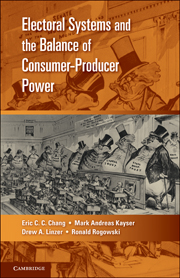Book contents
- Frontmatter
- Contents
- Acknowledgments
- 1 Introduction
- 2 Electoral Systems and Consumer Power: Theoretical Considerations
- 3 Electoral Systems and Real Prices: Panel Evidence for the OECD Countries, 1970–2000
- 4 Electoral Systems and Real Prices around the World
- 5 A Closer Look: Case Studies and Mechanisms
- 6 Socioeconomic Origins of Electoral Systems
- 7 Conclusion
- Bibliography
- Index
3 - Electoral Systems and Real Prices: Panel Evidence for the OECD Countries, 1970–2000
Published online by Cambridge University Press: 05 June 2012
- Frontmatter
- Contents
- Acknowledgments
- 1 Introduction
- 2 Electoral Systems and Consumer Power: Theoretical Considerations
- 3 Electoral Systems and Real Prices: Panel Evidence for the OECD Countries, 1970–2000
- 4 Electoral Systems and Real Prices around the World
- 5 A Closer Look: Case Studies and Mechanisms
- 6 Socioeconomic Origins of Electoral Systems
- 7 Conclusion
- Bibliography
- Index
Summary
In the article that originally motivated this book, Rogowski and Kayser (2002) performed only a plausibility check of the hypothesized link between electoral systems and real prices, based on cross-sectional analysis of OECD countries in 1990. The cross-sectional evidence was strongly supportive, suggesting that real prices were, controlling for all other influences commonly adduced and employing a broad array of robustness checks, about 10 percent lower in the average OECD country with single-member district (SMD) electoral systems than in those that used some form of proportional representation.
As with all new empirical claims – no one had previously even suggested a relationship between electoral arrangements and real prices – healthy skepticism was warranted. Indeed, recent research on related areas of public policy has contrasted with – but not contradicted – these price results, associating proportional electoral arrangements with such outcomes as (a) lower income inequality (Austin-Smith 2000; Birchfield and Crepaz 1998), (b) higher public spending (Persson and Tabellini 2003; Milesi-Feretti et al. 2002) or, in combination with central banking institutions, (c) greater price stability (Keefer and Stasavage 2003). As we noted in the previous chapter, and will treat more extensively later (Chapter 7), these outcomes – some of them desirable on non-utilitarian (e.g., Rawlsian) normative grounds – are almost always purchased at the cost of an overall reduction in social welfare; but it remains a question of (social) taste whether more equal slices are preferred to a larger pie, or whether greater growth is worth greater volatility. In this chapter, we restrict ourselves to a closer study of the price relationship among OECD countries.
- Type
- Chapter
- Information
- Publisher: Cambridge University PressPrint publication year: 2010

